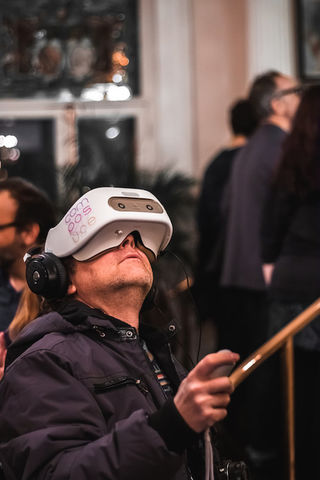Stress
Why Is Music So Healing?
New research and technologies highlight the healing power of music.
Posted May 24, 2019

If you’ve been feeling down, stressed-out, or have experienced a traumatic event, it could be a good time to seek support from music. From sensory baths using low tech, crystal bowls to high tech, 3D immersive environments using state-of-the-art audio/visual equipment—the neuroscience of music is underscoring what we’ve known intuitively for centuries: music has the ability to reduce stress, expand creativity, treat depression, and help us heal from traumatic events. Neurologists have found that music activates the brain in unique ways.1,2 Most of the time we don’t think of turning to music / sound to deal with life’s ups & downs, or more serious conditions, but we can. We can create our own musical healing treatment or turn to professionals for guidance3. Digital technologies have made it easier than ever to engage in a variety of low-tech and high-tech options—or combine them for additional support.
On the low-tech side, singing, drumming, and playing instruments, are some of the oldest healing techniques known to humanity. In many aboriginal cultures, “healing songs” are passed down from generation to generation—and fiercely protected from outsiders’ ears. Research conducted by Mallik, Chanda, and Levitin (2017) provides support for the growing evidence of the biological substrates of music. Their investigation of the neurochemical processes underlying music found that music uses the same reward pathways as food, drug and sexual pleasure.4

Singing is freely available—we can sing almost anytime—in the shower, on the way to work, while we’re hiking, cooking, or gardening. Instead of judging the quality of the sound that comes out—we need to let go and trust that healing is taking place at a deep level. Drumming is almost as readily accessible, but requires more of a set time and place. We can use digital technology to support singing or drumming by watching “how to” videos on YouTube, signing up for a class, looking for, or starting a local meet-up, for example, a drumming circle, or choir, in your community. If you’re not feeling up to those options, you might try a crystal bowl sound bath or Tibetan singing bowl meditation. Lauri Poldre, a computer and systems engineer, turned crystal bowl sound artist, explains the impact, “immersion in the sound bath induces Alpha and Theta brainwave states. These are the same states that we experience in meditation—states that are well-documented to induce relaxation and decrease stress.” Indeed, some researchers have found that sound waves affect the human nervous system more than traditional meditation.5 Another form of sound bath, Tibetan singing bowl meditation, has been around for centuries and has recently been the subject of research. Findings indicate that the sound baths significantly reduced tension, anger, fatigue and depressed mood in participants.6
If you’d rather immerse yourself in a high-tech sound experience, options include everything from listening to favorite playlists (curated with music that makes you feel good) to new immersive experiences designed to support stress-reduction and healing. Composer, Jeff McSpadden, a pioneer in the area of immersive audio design, founded Composure, for the latter purpose. Composure is a transformative tech company creating immersive experiences that use spatial and interactive audio to reduce stress and increase well-being. In addition to studying how powerful spatial audio can be when used as the focal point for an immersive experience, McSpadden’s team is creating experiences that give the user the ability to interact with music. The goal? Decreasing stress and promoting positive moods through engagement. McSpadden explains: “The relaxing and focusing effects of music are increased when you involve the listener.” Composure’s initial research supports this. In a recent research trial, Composure found the greatest driver of stress reduction came from the interaction between audio and visual elements and the agency each participant had in their experience.

“Composure’s experiences are built for the immersive web and work through a browser, which means they’re easy to access and work across all devices. Making sure high-tech experiences like ours meet people where they are is essential. We want to make sure our work can help as many people as possible.”, says McSpadden. To that end, Composure’s "Get Calm. Give Calm” campaign on Indiegogo is aimed at distributing their platform to those in need, such as trauma victims and other individuals coping with high occupational and situational stress. Doing so through the power of interactive music and sound makes it instantly accessible and relatable regardless of age, language or cultural background. By offering the platform to these individuals free of charge, McSpadden is engaging in digital altruism and leading the way in transformative tech.
Music and technology are stalwart supports that have served humanity for thousands of years . As we move further into an era that is already being defined by extraordinary advancements in healing, the work being done in sound healing is worthy of our serious attention.
References
1) Sachs, O. (2007) Musicophilia: Tales of music and the brain. New York: Knopf
2) Levitin, D. (2007) This is your brain on music: The science of a human obsession. New York: Plume/Penguin.
3) To find a professional music therapist, contact American Music Therapy Association https://www.musictherapy.org
4) 5) Mallik, A., Chanda, M.L., and Levitin, D. J. (2017) Anhedonia to music and mu-opioids: Evidence from the administration of naltrexone.Nature. https://www.nature.com/articles/srep41952
5) Landry, J.M. (2014). Physiological and psychological effects of a Himalayan singing bowl in meditation practice: a quantitative analysis.American Journal of Health Promotion 28(5):306-9. doi: 10.4278/ajhp.121031-ARB-528. https://www.ncbi.nlm.nih.gov/pubmed/23941101
6) Goldsby, T.L., Goldsby, M.E., McWalters, M., Mills, P.J. (2016). Effects of singing bowl sound meditation on mood, tension, and -: An observational study. Journal of Evidence-Based Complementary & Alternative Medicine, 22(3), 401–406. https://doi.org/10.1177/2156587216668109


